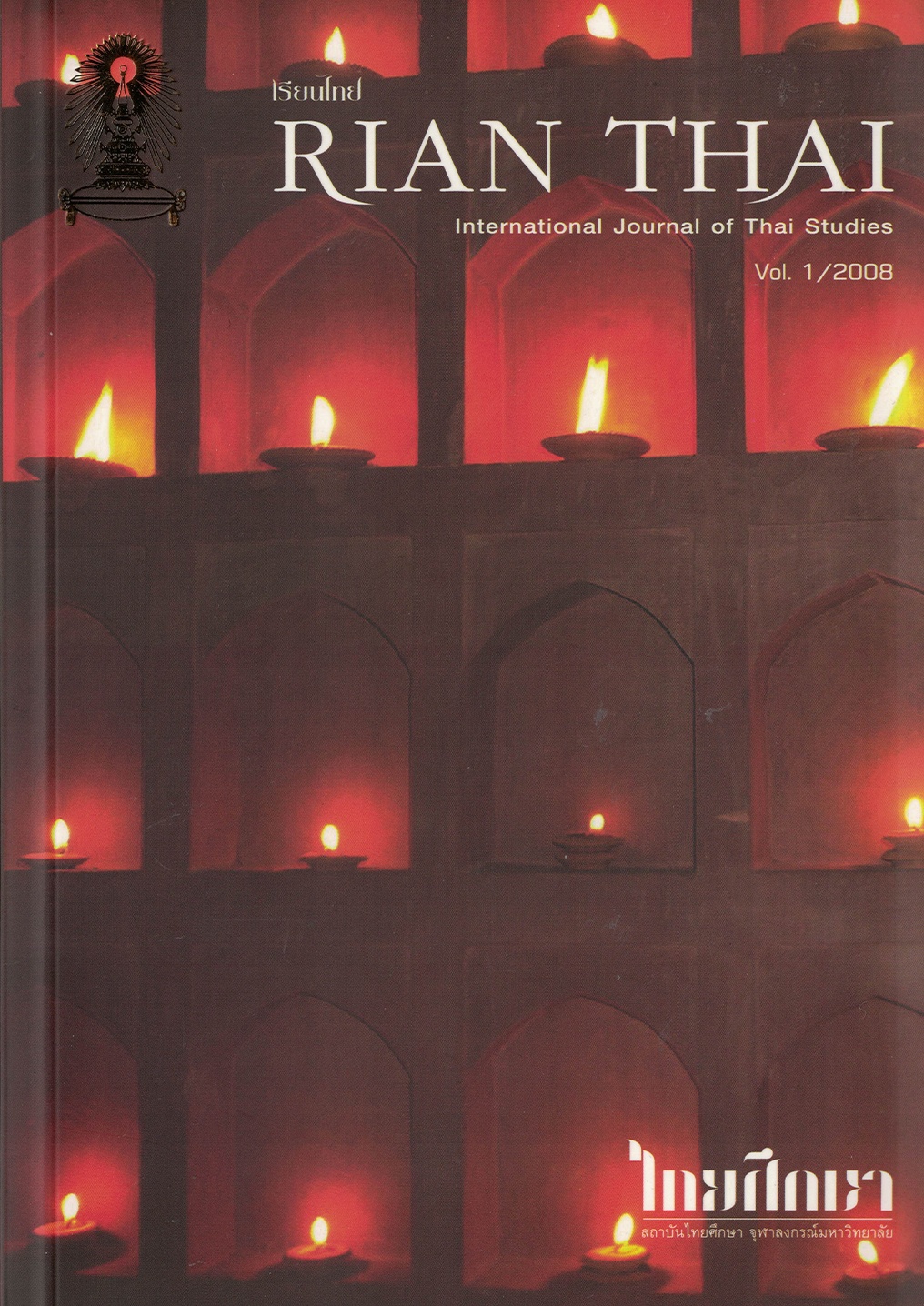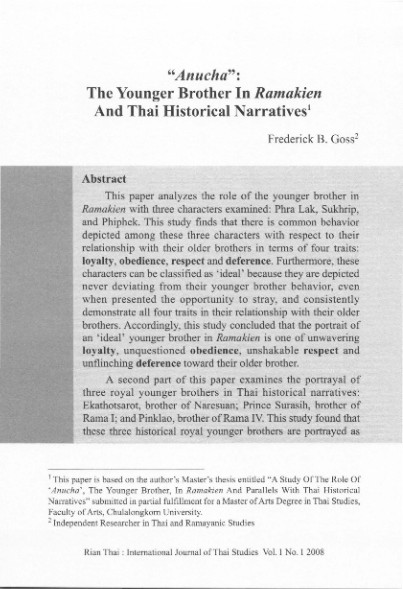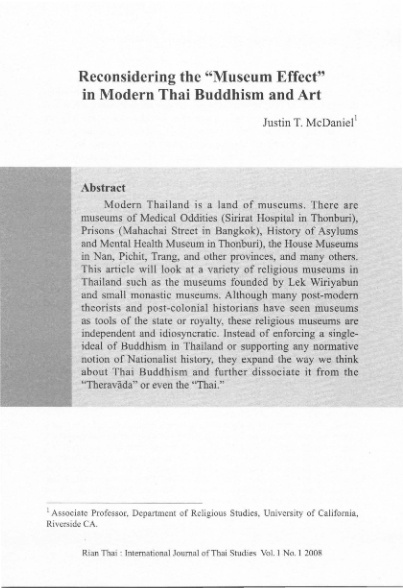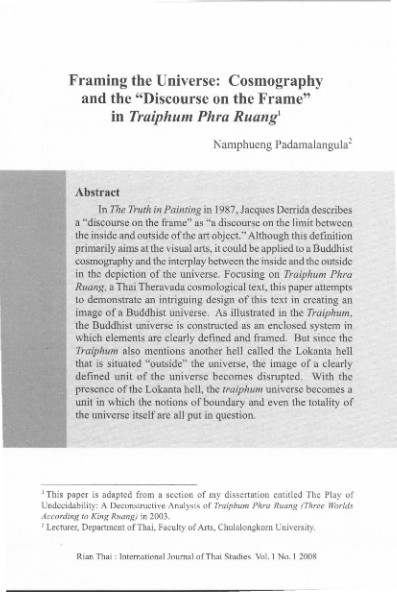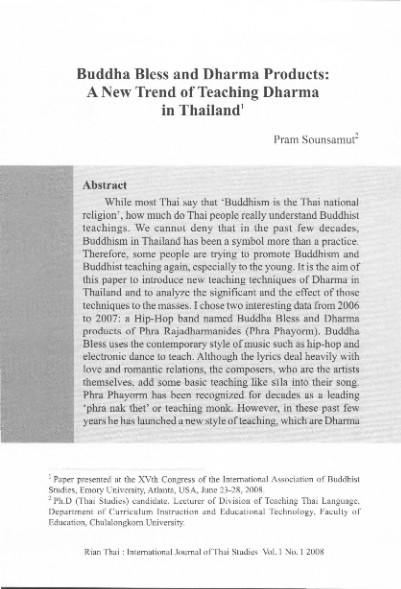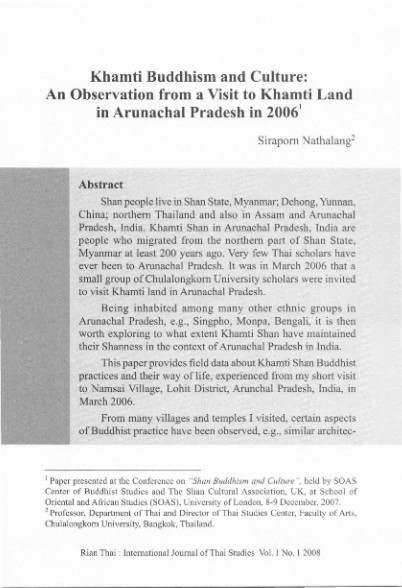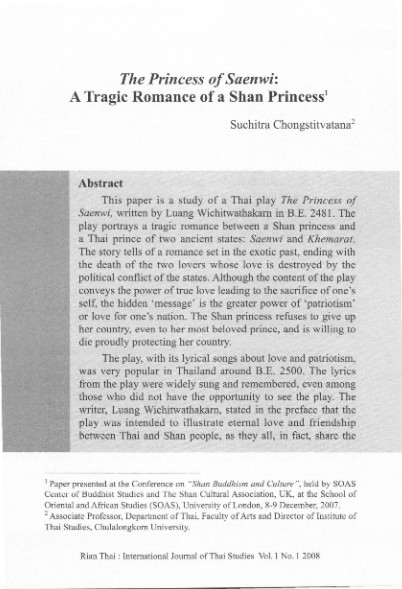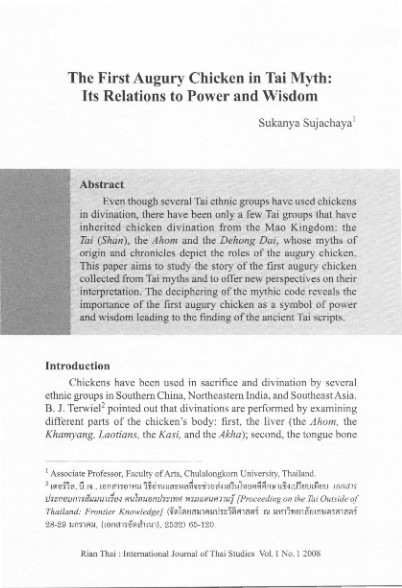Rian Thai - Volume 1/2008

1) Self-Sacrifice of the Kings in the Simhasana Dvatrisika and Thai Buddhist Narratives / Arthid Sheravanichkul
2) “Anucha” : The Younger Brother in Ramakien and Parallels with Thai Historical Narratives / Frederick B. Goss
3) Reconsidering the ‘Museum Effect’ in Modern Thai Buddhism and Art / Justin T. McDaniel
4) Framing the Universe : Cosmography and the “Discourse of the Frame” in Traiphum Phra Ruang / Namphueng Padamalangula
5) Dhammakaya, Tathagatagarbha and Other-Emptiness : A Comparison between Luang Pho Sot’s Thammakai Meditation System and Tibetan Shentong Tradition / Potprecha Cholvijarn
6) Buddha Bless and Dharma Products : A New Trend of Dharma Teaching in Thailand / Pram Sounsamut
7) Khamti Buddhism and Culture : An Observation from a Visit to Khamti Land in Arunachal Pradesh in 2007 / Siraporn Nathalang
8) The Princess of Saenwi : A Tragic Romance of a Shan Princess / Suchitra Chongstitvatana
9) The First Augury Chicken in Thai Myth : Its Relations to Power and Wisdom / Sukanya Sujachaya
Self-Sacrifice of the Kings in the Simhasana Dvatrisika and Thai Buddhist Narratives
Arthid Sheravanichkul
Abstract
This paper aims to study narratives from the Simhasana Dvatrimsika and Thai Buddhist narratives from the Pannasa Jataka and the Anagatavamsa in which the main characters are the kings who sacrifice their lives. In the Simhasana Dvatrimsika, regarded as a eulogy of King Vikramaditya, one of the greatest heroes of India, he is characterized as a highly generous king who gives everything for the sake of others. In ten out of thirty-two stories, the king sacrifices his life in order to satisfy the deities, to help others, and to save others' lives. In Thai Buddhist narratives: the Pannasa Jataka and the Anagatavamsa, the self-sacrifice of kings is also found. However, it is not intended to prove his righteousness as a king per se, but to demonstrate the highest level of the perfection of generosity. In the Panniisa Jiitaka, there are four stories in which the king bodhisattva sacrifices his body and life with devotion and compassion to Sakka who comes in disguise to test him by begging for parts of body, or by asking for his body as an offering to a sermon. Also, in the Anagatavamsa, there are two stories in which the king bodhisattvas devoutly cut off their heads as offerings to the sermons of the Buddhas.
From the study, the self-sacrifice of the kings in the Simhasana Dvatrimsika and Thai Buddhist narratives seem to be approximately similar; the kings are tested and then sacrifice their lives to the deities, or they liberally sacrifice themselves for the sake of others. But actually, the concept and purpose of such sacrifice are distinctly different. In the Simhasana Dvatrimsika, the liberality of King Vikramaditya is woven with devotion, honesty and courage. These inspiring virtues prove him to be an ideal king in the "Hindu" context. In the Buddhist context, meanwhile, the self-sacrifice of a king is merged with the concept of Danaparami – the perfection of generosity. Through the sacrifice, the bodhisattvas renounce kingship and completely become a 'qualified' bodhisattva who fulfils the Danaparami. Buddhahood is the otherworldly goal for him not the worldly pleasures or the ephemeral status of a king.
(Published in Rian Thai: International Journal of Thai Studies, Volume 1/2008, Page 1-23)
Full Text : Download
“Anucha” : The Younger Brother in Ramakien and Parallels with Thai Historical Narratives
Frederick B. Goss
Abstract
This paper analyzes the role of the younger brother in Ramakien with three characters examined: Phra Lak, Sukhrip,and Phiphek. This study finds that there is common behavior depicted among these three characters with respect to their relationship with their older brothers in terms of four traits: loyalty, obedience, respect and deference. Furthermore, these characters can be classified as 'ideal' because they are depicted never deviating from their younger brother behavior, even when presented the opportunity to stray, and consistently demonstrate all four traits in their relationship with their older brothers. Accordingly, this study concluded that the portrait of an 'ideal' younger brother in Ramakien is one of unwavering loyalty, unquestioned obedience, unshakable respect and unflinching deference toward their older brother.
A second part of this paper examines the portrayal of three royal younger brothers in Thai historical narratives: Ekathotsarot, brother of Naresuan; Prince Surasih, brother of Rama I; and Pinklao, brother of Rama IV. This study found that these three historical royal younger brothers are portrayed a loyal companions, obedient servants, respectful attendants and deferential followers of their older brothers, the same qualities identified as defining the 'ideal' younger brother in Ramakien.
The findings from this study indicate that an important aspect of traditional Thai society has been the desire to project and uphold the 'ideal', as represented by the behavior shown in younger brother characters in Ramakien and paralleled in the portrayal of the younger brothers in Thai historical narratives.
(Published in Rian Thai: International Journal of Thai Studies, Volume 1/2008, Page 25-52)
Full Text : Download
Reconsidering the ‘Museum Effect’ in Modern Thai Buddhism and Art
Justin T. McDaniel
Abstract
Modern Thailand is a land of museums. There are museums of Medical Oddities (Sirirat Hospital in Thonburi), Prisons (Mahachai Street in Bangkok), History of Asylums and Mental Health Museum in Thonburi), the House Museums in Nan, Pichit, Trang, and other provinces, and many others. This article will look at a variety of religious museums in Thailand such as the museums founded by Lek Wiriyabun and small monastic museums. Although many post-modern theorists and post-colonial historians have seen museums as tools of the state or royalty, these religious museums are independent and idiosyncratic. Instead of enforcing a singleideal of Buddhism in Thailand or supporting any normative notion of Nationalist history, they expand the way we think about Thai Buddhism and further dissociate it from the "Theravada" or even the "Thai."
(Published in Rian Thai: International Journal of Thai Studies, Volume 1/2008, Page 53-69)
Full Text : Download
Framing the Universe Cosmography and the “Discourse of the Frame” in Traiphum Phra Ruang
Namphueng Padamalangula
Abstract
In The Truth in Painting in 1987, Jacques Derrida describes a "discourse on the frame" as "a discourse on the limit between the inside and outside of the art object." Although this definition primarily aims at the visual arts, it could be applied to a Buddhist cosmography and the interplay between the inside and the outside in the depiction of the universe. Focusing on Traiphum Phra Ruang, a Thai Theravada cosmological text, this paper attempts to demonstrate an intriguing design of this text in creating an image of a Buddhist universe. As illustrated in the Traiphum, the Buddhist universe is constructed as an enclosed system in which elements are clearly defined and framed. But since the Traiphum also mentions another hell called the Lokanta hell that is situated "outside" the universe, the image of a clearly defined unit of the universe becomes disrupted. With the presence of the Lokanta hell, the traiphum universe becomes a unit in which the notions of boundary and even the totality of the universe itself are all put in question.
(Published in Rian Thai: International Journal of Thai Studies, Volume 1/2008, Page 71-85)
Full Text : Download
Dhammakaya, Tathagatagarbha and Other-Emptiness : A Comparison between Luang Pho Sot’s Thammakai Meditation System and Tibetan Shentong Tradition
Potprecha Cholvijarn
Abstract
The aim of this essay is to show two systems of thought that developed in different countries and different Buddhist traditions during different periods of time and relying on different scriptural sources, sharing similar views on the nature of absolute reality. These two views are both founded upon a meditative and an intuitive understanding of reality and aim at presenting its nature exactly as it appears to the meditator's awareness.This article is divided into five parts, the first part talks about the tathagatagarbha doctrine, the second about the Tibetan emptiness-of-other (shentong/gzhan stong) tradition and its views, the third talks about thammakai meditation system and its views as taught by Luang Pho Wat Paknam., Phra Mongkhon Thepmuni (Sot Candasaro) หลวงพ่อวัดปากน้ำ พระมงคลเทพมุนี (สด จนฺทสโร) , the fourth part is a doctrinal comparison between the shentong and thammakai systems followed by a brief conclusion.
This essay attempts to raise questions regarding the Buddhist understanding of the nature of reality, the dividing line between wrong and right views and the role of meditative intuition and conceptualization in Buddhist practice. The author hopes that further academic studies on this topic would arrive at a better understanding of the variety, the complexity, and the over-lapping features of Mahayana and Theravada traditions and raise further interests in the academic study of Luang Pho Sot's teaching.
(Published in Rian Thai: International Journal of Thai Studies, Volume 1/2008, Page 87-106)
Full Text : Download
Buddha Bless and Dharma Products : A New Trend of Dharma Teaching in Thailand
Pram Sounsamut
Abstract
While most Thai say that 'Buddhism is the Thai national religion', how much do Thai people really understand Buddhist teachings. We cannot deny that in the past few decades, Buddhism in Thailand has been a symbol more than a practice. Therefore, some people are trying to promote Buddhism and Buddhist teaching again, especially to the young. It is the aim of this paper to introduce new teaching techniques of Dharma in Thailand and to analyze the significant and the effect of those techniques to the masses. I chose two interesting data from 2006 to 2007: a Hip-Hop band named Buddha Bless and Dharma products of Phra Rajadharmanides (Phra Phayorm). Buddha Bless uses the contemporary style of music such as hip-hop and electronic dance to teach. Although the lyrics deal heavily with love and romantic relations, the composers, who are the artists themselves, add some basic teaching like slla into their song. Phra Phayorm has been recognized for decades as a leading 'phra nak thet' or teaching monk. However, in these past few years he has launched a new style of teaching, which are Dharma products. Instead of teaching verbally, Phra Phayom has used trendy products such as wrist-bands, animations, cookies, t-shirts, paper bags, to teach Dharma. As a result, many youth and middle aged people are attracted to this kind of teaching technique. This new style of teaching is easier to understand and to use in their real life than are the classical texts. For better or worse, hopefully, these are another way of sustaining Buddhist teaching in modem Thai society.
(Published in Rian Thai: International Journal of Thai Studies, Volume 1/2008, Page 107-128)
Full Text : Download
Khamti Buddhism and Culture : An Observation from a Visit to Khamti Land in Arunachal Pradesh in 2007
Siraporn Nathalang
Abstract
Shan people live in Shan State, Myanmar; Dehong, Yunnan, China; northern Thailand and also in Assam and Arunachal Pradesh, India. Khamti Shan in Arunachal Pradesh, India are people who migrated from the northern part of Shan State, Myanmar at least 200 years ago. Very few Thai scholars have ever been to Arunachal Pradesh. It was in March 2006 that a small group of Chulalongkom University scholars were invited to visit Khamti land in Arunachal Pradesh.
Being inhabited among many other ethnic groups in Arunachal Pradesh, e.g., Singpho, Monpa, Bengali, it is then worth exploring to what extent Khamti Shan have maintained their Shanness in the context of Arunachal Pradesh in India.
This paper provides field data about Khamti Shan Buddhist practices and their way of life, experienced from my short visit to Namsai Village, Lohit District, Arunchal Pradesh, India, in March 2006.
From many villages and temples I visited, certain aspects of Buddhist practice have been observed, e.g., similar architecture of chedi, tiered roof temples, the worship of Uppakutta, the
Sangkaen festival, the Buddhist tradition of poi lu lik (dana Dhamma) in which people offer lik (Buddhist script) to monks for special reasons; certain lik for certain purposes. This paper
provides names of lik and their occasions offered to the monk, which will help us understand how Khamti Shan make use of Buddhism in their worldly life. It is also observed that Khamti Buddhism co-exists with Hinduism and also indigenous beliefs.
Other aspects of Khamti culture were also collected. Remnants of Chaofa's (prince's) families and Shan chaofa's political system can still be traced. Khamti Shan housing style, including rice barns and weaving looms were also pictured. Certain Khamti myths, folktales, folksongs and folklife were also collected.
Overall, it is fascinating to learn that the Khamti in Arunachal Pradesh retain, to a large extent, their Shanness as if they were still in northern Shan State where they departed a long time ago.
(Published in Rian Thai: International Journal of Thai Studies, Volume 1/2008, Page 129-146)
Full Text : Download
The Princess of Saenwi : A Tragic Romance of a Shan Princess
Suchitra Chongstitvatana
Abstract
This paper is a study of a Thai play The Princess of Saenwi, written by Luang Wichitwathakam in B.E. 2481. The play portrays a tragic romance between a Shan princess and a Thai prince of two ancient states: Saenwi and Khemarat.
The story tells of a romance set in the exotic past, ending with the death of the two lovers whose love is destroyed by the political conflict of the states. Although the content of the play conveys the power of true love leading to the sacrifice of one's self, the hidden 'message' is the greater power of 'patriotism' or love for one's nation. The Shan princess refuses to give up her country, even to her most beloved prince, and is willing to die proudly protecting her country.
The play, with its lyrical songs about love and patriotism, was very popular in Thailand around B.E. 2500. The lyrics from the play were widely sung and remembered, even among those who did not have the opportunity to see the play. The writer, Luang Wichitwathakam, stated in the preface that the play was intended to illustrate eternal love and friendship between Thai and Shan people, as they all, in fact, share the same Tai cultural heritage. Seen in this light, the play belongs to a special 'genre' of literary works of that period propagating 'patriotism' and 'pride' of Thai-Tai people. The reference to the Shan state and the 'passionate' and 'courageous' characters of the Shan princess clearly reflect the 'image' of the Shan in the mind of Thais.
The Princess of Saenwi could be seen as a 'representation of Shanness' in the Thai perception. This can also be traced in the Shan characters in the contemporary novel by Krisana Asoksin, Khun Ho Kham. As a 'literary work' the play is a crystallization of the mutual acceptance and admiration of Thai-Tai culture in these modem times.
(Published in Rian Thai: International Journal of Thai Studies, Volume 1/2008, Page 147-159)
Full Text : Download
The First Augury Chicken in Thai Myth : Its Relations to Power and Wisdom
Sukanya Sujachaya
Abstract
Even though several Tai ethnic groups have used chickens in divination, there have been only a few Tai groups that have inherited chicken divination from the Mao Kingdom: the Tai (Shan), the Ahom and the Dehong Dai, whose myths of origin and chronicles depict the roles of the augury chicken. This paper aims to study the story of the first augury chicken collected from Tai myths and to offer new perspectives on their interpretation. The deciphering of the mythic code reveals the importance of the first augury chicken as a symbol of power and wisdom leading to the finding of the ancient Tai scripts.
(Published in Rian Thai: International Journal of Thai Studies, Volume 1/2008, Page 161-190)
Full Text : Download
